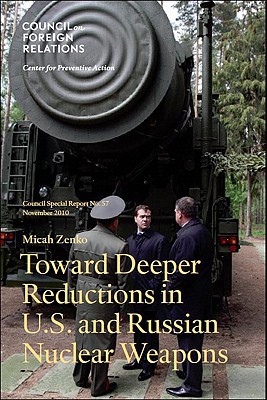All books / Book
Toward Deeper Reductions in U.S. and Russian Nuclear Weapons (Council Special Report)

| Full title: | Toward Deeper Reductions in U.S. and Russian Nuclear Weapons (Council Special Report) |
|---|---|
| ISBN: | 9780876094822 |
| ISBN 10: | 0876094825 |
| Authors: | |
| Publisher: | Council On Foreign Relations |
| Num. pages: | 56 |
| Binding: | Paperback |
| Language: | en |
| Published on: | 2010 |
Read the reviews and/or buy it on Amazon.com
Synopsis
Annotation In 2009, Presidents Barack Obama And Dmitry Medvedev Pledged To Sign A Bilateral Treaty To Limit The Nuclear Arsenals Of The United States And Russia To Approximately 1,500 Deployed Nuclear Weapons And 750 Delivery Systems. While This Represents A Significant Reduction From Cold War-era Levels, The Two Countries Still Retain More Than 90 Percent Of The World's Nuclear Weapons. As Good-faith Progress Toward President Obama's Stated Commitment To Seek The Peace And Security Of A World Without Nuclear Weapons, Both Countries Need To Begin Negotiating A Follow-up Bilateral Treaty To Reduce Their Respective Arsenals. Micah Zenko Offers Specific Recommendations For U.s. Policy On Four Strategic And Technical Issues That Such A Treaty Would Raise: Beginning High-level Discussions With U.s. Allies On The Tradeoffs Between Extended Deterrence And Deeper Nuclear Cuts Promoting The Joint U.s.-russia Development Of Missile Defense Radar And Interceptors Proposing Transparency And Confidence-building Measures For Deployed U.s. And Russian Tactical Nuclear Weapons Developing A Framework To Account For Deploying Advanced Conventional Weapons On Nuclear-capable Delivery Systems. At A Time Of Global Nuclear Uncertainty, This Report Defines A Path To Greater Security And Commitment To A Nonnuclear World. Introduction -- Moving Toward One Thousand -- Nuclear Forces After The New Start Treaty -- Tactical Nuclear Weapons -- Missile Threats And Missile Defenses -- Conventional Weapons On Nuclear-capable Delivery Systems -- Conclusion And Recommendations. Micah Zenko. November 2010 -- T.p. Includes Bibliographical References (p.23-26).